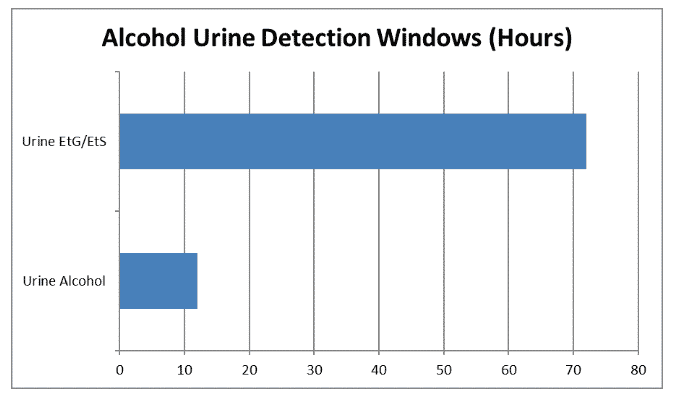How Long Does Alcohol Stay in Your System?
Written by Erica Weiman
& Medically Reviewed by Leila Khurshid BCPS, PharmD
Medically Reviewed
Last updated: 02/19/2025
There can be a fine line between “having a good time” and alcohol abuse. Many factors can influence an individual’s response to alcohol, including gender, food intake, other medications and genetics.
Alcohol is a depressant and works by slowing signals between the body and brain. Over time, the body adjusts to the presence of alcohol and withdrawal symptoms may occur if alcohol consumption stops. Symptoms of withdrawal can vary from mild trembles to severe hallucinations and seizures.
How Long Does Alcohol Stay in Your System?
When someone drinks alcohol, the vast majority is broken down by the liver, and a tiny amount is expelled through breath and sweat. The remaining 1–2% is excreted in the urine. Alcohol will usually show up in a person’s urine within an hour of drinking, and it usually remains detectable for up to 12 hours. The actual timeframe may vary, depending on a number of factors, including weight, health, gender and the amount of alcohol consumed.
How Long Does It Take to Process Alcohol?
One standard drink contains about 14 grams of alcohol, the amount found in:
- A 12-ounce beer with 5% alcohol by volume
- A five-ounce glass of wine with 12% alcohol
- A 1.5-ounce serving or “shot” of 80-proof distilled spirits with 40% alcohol
Once swallowed, alcohol enters the stomach and small intestine and from there, it is absorbed into small blood vessels which carry it to the bloodstream. Approximately 20% of alcohol is absorbed through the stomach and the remainder through the small intestine. Alcohol is then metabolized by liver enzymes in the liver.
Alcohol Half-Life
The half-life of alcohol is approximately five hours. This is the time it takes for half of the alcohol ingested to be metabolized and excreted. It takes about five half-lives to fully metabolize and eliminate a substance, so this means it would take about 25 hours for alcohol to be fully eliminated.
How Long Does It Take for Alcohol to Kick In?
As with any other substance, there are many factors that can affect how quickly or slowly a person would feel the effects of alcohol. Generally, alcohol’s effects are felt within about 10–60 minutes. However, this can be slowed by many factors, including gender, food consumed, other medications and genetics.
How Long Is Alcohol Detectable?
Alcohol is in your system only as long as it is found in your bloodstream. Even after its effects have worn off, it can still be present in body fluids or tissues and may be detectable once you are sober.
How Long Does Alcohol Stay in Your Urine?
While 92-98% of alcohol is metabolized in the liver, the remaining 2-8% leaves the body through urine, sweat and breath. Some drugs can show up in a person’s urine for days or weeks, but alcohol has a much shorter detection window. A urine screening can typically detect ethanol — the type of alcohol found in alcoholic beverages — for up to 12 hours.
There are other types of urine tests, such as EtG and EtS tests, that can identify traces of alcohol byproducts for up to 72 hours after a person’s last drink, but those tests have significant limitations.
Urine alcohol content is sometimes used to estimate a person’s blood alcohol content. The amount of alcohol in a person’s urine is approximately 1.33 times greater than the amount of alcohol in their bloodstream. For accuracy, at least two urine samples are usually collected 30 minutes to an hour apart.

How Long Does Alcohol Stay in Your Blood?
In general, the liver processes one ounce of liquor or one standard drink per hour. If you consume more than this, the additional alcohol accumulates in the blood and body tissues until it can be metabolized. This is why consuming many drinks can result in high blood alcohol concentrations that lasts for several hours.
You may need a blood alcohol test if you are suspected of drunk driving and/or have symptoms of intoxication after an accident. These include:
- Difficulty with balance and coordination
- Slurred speech
- Slowed reflexes
- Nausea and vomiting
- Mood changes
- Poor judgment
How Long Does Alcohol Stay on Your Breath?
Commonly known as breathalyzers, breath alcohol tests (BATs) are administered by a technician, and results are available immediately. Among breathalyzers, Evidential Breath Testing devices (EBTs) are the gold standard. The results of an EBT can be legally used in a court case.
There are many factors that can affect the reliability of breathalyzers and possibly even result in false positives:
- Temperature: Breathalyzers can be sensitive to temperature and will give false readings if not adjusted or recalibrated.
- Breathing pattern: Hyperventilation for 20 seconds has been shown to lower the reading by approximately 32%.
- Diet: Dieters and diabetics may have acetone levels hundreds or even thousands of times higher than others, which can result in a false positive.
- Medications: Metered-dose inhalers (MDIs) used in asthma treatment are also a cause of false positives.
How Long Does Alcohol Remain in Saliva?
Alcohol typically lingers in saliva for around 12 to 24 hours after drinking. Although saliva testing can detect alcohol, this approach is fairly uncommon compared to breath, urine, or blood tests.
How Long Can Alcohol Be Detected in Hair?
Hair-based tests generally reveal whether alcohol was consumed at any point during the past 90 days. However, while a hair test can confirm alcohol use, it cannot determine how much was consumed or specify the timing of consumption during that period.
How Long Does Alcohol Stay in Breast Milk?
Alcohol does pass into breast milk, and if you drink shortly before nursing, it may be transferred to your baby. The duration alcohol stays in breast milk is influenced by the number of drinks consumed; for each drink, you can expect an additional two to three hours before the alcohol clears your system.
How Long Do the Effects of Alcohol Last?
While there is variation from state to state, in most places you are considered legally intoxicated with a BAC of 0.8%. It can take up to six hours for your BAC level to drop from 0.08% to 0.00% and anything above 0.00% is illegal for anyone under 21.
A common guideline is that, after each typical drink, you should wait 45 minutes before attempting to drive.
How to Sober Up Fast
There are many factors that influence how long it takes for a person’s body to process alcohol, including:
- Gender: Women feel the effects of alcohol more than men for two major reasons. Women have less body water, meaning that the same amount of alcohol in a man’s body would be more diluted and therefore a man would feel less of an effect from alcohol. Women also naturally have less of the enzyme responsible for breaking down alcohol, which means it will take longer for a woman to metabolize the same amount of alcohol as a man.
- Food: Eating will dilute the alcohol and slow the emptying of the stomach into the small intestine, where alcohol is rapidly absorbed.
- Genetics: Some people of Asian descent may experience facial flushing, nausea, headache, dizziness and rapid heartbeat after drinking. It appears that one of the liver enzymes that is needed to process alcohol is not active in these individuals.
- Other medications/substances: Because alcohol is a depressant, taking it with other depressants, like benzodiazepines or opiates, for example, can increase the effect of alcohol.
There are many myths about how to sober up faster like taking a cold shower or drinking coffee, but the only way to get the alcohol out of your system is to give your body time to metabolize it.
How Long Can a Hangover Last?
There are many factors that can influence the length of a hangover. Body weight and gender are important factors, with five to eight drinks for the average man and three to five drinks for the average woman being enough to cause some degree of hangover that can last up to 72 hours. The duration of a hangover depends on how much alcohol was consumed, dehydration, nutritional status, ethnicity, gender, the state of your liver and other medications.
There are many remedies marketed as “hangover cures,” but none have much evidence to support their use. It can help to stay hydrated and to avoid ingesting anything else that can further tax the liver, like “hair of the dog” — more alcohol — or Tylenol, as these can lead to swelling or liver failure.
Alcohol Withdrawal
If you drink consistently or heavily for days, weeks or longer, you may become physically dependent and experience uncomfortable or dangerous symptoms when you try to cut back or stop. This is called withdrawal.
Symptoms of withdrawal can range from mild to severe. Within six hours of stopping drinking, mild symptoms can appear:
- Anxiety
- Shaky hands
- Nausea
- Vomiting
- Insomnia
- Sweating
Between 12–24 hours after your last drink, symptoms can progress to hallucinations or seizures. After 48 hours, symptoms can continue to progress even further to delirium tremens (DTs) with more vivid hallucinations and delusions.
We are here for you.
If you or a loved one is struggling with addiction, our expert team is here to guide you every step of the way. Don’t wait—start your journey to recovery today.
Alcohol Addiction Treatment
If you or someone you love is struggling with alcohol addiction, we can help. Contact The Recovery Village at Palmer Lake to learn about safe and effective alcohol detox and addiction treatment programs, what to expect and how to start treatment.
We offer inpatient, medical detox, intensive outpatient and partial hospitalization program (PHP) services based on your needs. Our 110-bed facility is located near Colorado Springs, with breathtaking vistas and scenic views. We are one of several facilities in The Recovery Village network and are also a member of the National Association of Addiction Treatment Providers (NAATP). Start your healthier future today.
Self-Assessment: Am I An Alcoholic?
There’s a fine line between excessive alcohol consumption and an alcohol use disorder, and it’s not always easy to determine which side you’re on. If you’re concerned that drinking has become an addiction, consider the following online assessments. These tests can help you determine if you’re addicted to alcohol by evaluating your drinking habits. For the most accurate assessment, be completely honest with your responses. The tests are 100% confidential and free:
The Recovery Village at Palmer Lake has a proven track record of providing caring and successful alcohol abuse treatment at our beautiful facilities in Palmer Lake, Colorado. Contact one of our team members today to learn how alcohol rehab can benefit you or your loved ones.
Sources
National Institute of Alcohol Abuse & Alcoholism. “What Is A Standard Drink?” Accessed February 21, 2022.
Jones, AW. “Alcohol, its absorption, distribution, m[…]kinetic calculations.” WIREs: Wiley Interdisciplinary Reviews, May 20, 2019. Accessed March 15, 2022.
University of California Santa Cruz. “Alcohol and Your Body.” Student Health Outreach & Promotion, December 20, 2019. Accessed February 21, 2022.
Tomo Drug Testing. “Does Alcohol Show Up in a Drug Test?” March 8, 2016. Accessed February 21, 2022.
Reisfield, GM; Goldberger, BA; et al. “Ethyl glucuronide, ethyl sulfate, and et[…]ased hand sanitizer.” Journal of Analytical Toxicology, March 2011. Accessed June 16, 2021.
AlcoDigital. “What Causes Breathalyzer Errors And/Or False Positives?” February 13, 2019. Accessed February 21, 2022.
DrinkingandDriving.org. “The Truth About Blood Alcohol Content aka BAC.” Accessed February 21, 2022.
Johns Hopkins Medicine. “Hangover Headache.” Accessed February 21, 2022.
World Health Organization (WHO). “Withdrawal Management.” Clinical Guidelines for Withdrawal Management and Treatment of Drug Dependence in Closed Settings, 2009. Accessed March 15, 2022.
Cleveland Clinic. “How Long Does Alcohol Stay in Your System?” Health Essentials, December 3, 2021. Accessed February 21, 2022.Hadland, Scott; and Levy, Sharon. “Objective Testing – Urine And Other Drug Tests.” Child and Adolescent Psychiatric Clinics of North America, March 30, 2016. Accessed February 21, 2022.
Authorship





